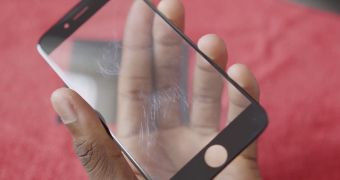A new video by YouTuber Marques Brownlee shows how durable the new iPhone 6 display is. No surprises here: a crossbow arrow will destroy it no matter what.
The guy that impressed everyone by getting his hands on the iPhone 6 display and bending it a lot, has some new, more in-depth tests for the same screen. This time, he explains how he realized that the display panel may actually not be made of sapphire glass, but a composite material that has some percentage of sapphire in it.
He starts off by explaining the metal in his knife and keys is not relevant to a supposedly sapphire or even to Corning Gorilla Glass because they are less hard on the Mohs Scale (mineral hardness scale). According to this scale, the knife blade has a hardness of 5.5, the iPhone 5s display is at around 6.8 and the pure sapphire goes up to 9.0.
Scratching your iPhone 5s with hard sandpaper does scratch the screen pretty badly, but it won't leave a mark on the Touch ID Home button that we know is made out of sapphire glass.
However, the same sandpaper left scratch marks on the supposedly sapphire display. Maybe that's because the screen itself is not made out of sapphire, says Brownlee. He believes that the new display is actually a composite that is harder than the Corning's Gorilla Glass display. Marques does say the non-sapphire display is the correct choice, because a full sapphire panel is not that bendable and it is much more expensive.
It appears that Apple has already patented a way to laminate with sapphire. "Once the two sheets are joined together to form the sapphire laminate, the exposed surfaces of the sapphire laminate may be lapped and polished. Both exposed surfaces of the sapphire laminate may be lapped and polished simultaneously. That is, the sapphire laminate may be immersed in an abrasive and/or polishing slurry with a polishing pad on each side. The sapphire structure may also be mechanically modified to help reduce the likelihood of chipping or fracturing. For example, the edges may be beveled or chamfered. Further, the sapphire structure may be treated with oleophobic coating and/or printed with ink," explains the Patent filling from March of 2013.
The last part of his video shows how the display can be destroyed using a crossbow arrow this time. No surprise here. We already know that just by going over it with a car will shatter the glass.

 14 DAY TRIAL //
14 DAY TRIAL // 
